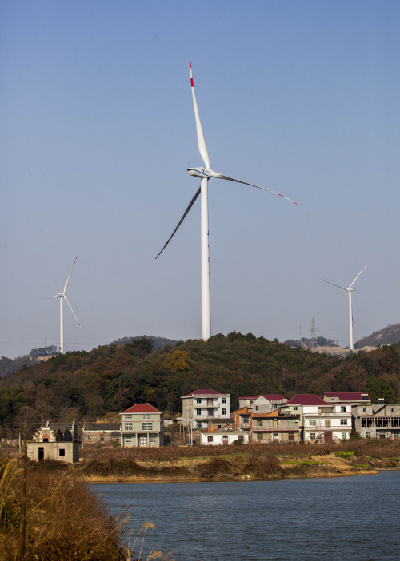|
 |
|
GREEN ENERGY AMBITION: Windmills built by China Huaneng Group stand nearby the Poyang Lake in Duchang County, south China's Jiangxi Province (FU JIANBIN) |
Revised GDP
China revised its 2013 economic data, adding 3.4 percent for a final total of 58.8 trillion yuan ($9.61 trillion).
The upward revision, based on more comprehensive data on the manufacturing and service sectors following China's twice-a-decade economic census, will not affect economic growth this year, the National Bureau of Statistics (NBS) said in a statement on its website.
This marks an increase of 1.92 trillion yuan ($308.41 billion) from the previous count.
"The revision of 2013 GDP will affect the size of 2014 GDP, but basically will not affect GDP growth for 2014," NBS said, adding that it was still revising GDP figures for previous years but the work had not been completed.
Despite impressive growth over the past few decades, China's economy was still 56.5 percent the size of the United States after the revision, based on average exchange rates in 2013, according to the NBS.
Its per-capita GDP in 2013 was raised to $6,995 from $6,767, but this was only about two thirds of the world's average level, the bureau said.
Formidable Home Prices
More than half of Chinese citizens surveyed said homes were too expensive for them, in the latest national poll by the People's Bank of China.
The survey showed that 58.8 percent of 20,000 people surveyed in 50 cities believe current home prices were "too high to accept" in the fourth quarter of 2014, down 0.7 percentage point from the previous quarter.
The property market cooled in 2014, with authorities loosening controls on purchases, mortgage rules and interest rates to avoid an even sharper slowdown. Home prices--especially in large cities--are still too high for most new graduates.
Of urban residents, 52.9 percent considered current prices "too high," down 1.1 percentage points, as the consumer price index, the main gauge of inflation, edged up 1.4 percent year on year in November, the slowest increase since November 2009.
Government Net Assets
The total net assets of the Chinese Government, including government executive departments, legislative departments and justice departments was 55.3 trillion yuan ($9 trillion) in 2013, according to research published on December 20.
In a broad measurement that also included government-backed public institutions and associations, the government's net assets stood at 92.3 trillion yuan ($14.83 trillion) in 2013, according to the finance research institute under the People's Bank of China.
The total net assets of China's public departments, including the government's net assets as well as government-controlled companies, stood at 106.9 trillion yuan ($17.17 trillion).
"Given China's relatively huge foreign exchange reserves, the Chinese Government has a good foundation for economic control," the finance research institute said.
It added that the government's net assets were substantial and also demonstrated structural stability and fitness.
Connect Karst Regions
Construction of China's first high-speed railway running through the country's southwest karst regions was completed on December 21.
The 857-km railway linking Guiyang, capital of landlocked mountainous province of Guizhou, with south China's economic powerhouse Guangzhou, is expected to become operational on December 26.
Guizhou has the world's most typical karst plateau landscape, which was inducted as a UNESCO World Heritage Site in 2007. Karst topography is a landscape formed from the dissolution of soluble rocks such as limestone.
Stretching through the complicated karst clusters, the railway has half of its length run through 238 tunnels, two of which are more than 14 km long, said Zhang Jianbo, General Manager of Guiyang-Guangzhou High-Speed Railway Co.
It took builders four years to drill through the two longest tunnels. Construction was often disrupted by breaking rocks, rupturing strata and water infiltration, Zhang said.
The construction company applied for six national patents covering their shockproof technology, which was adopted to reduce the vibration that occurs when a train travelling at 250 km per hour runs through mountain tunnels.
| 